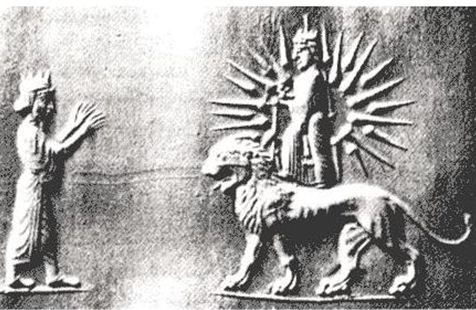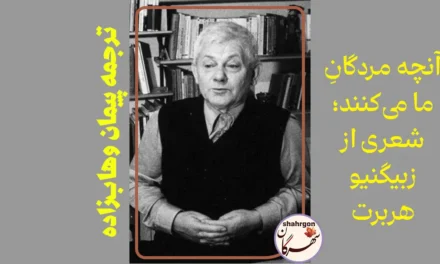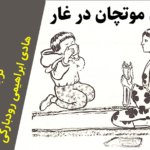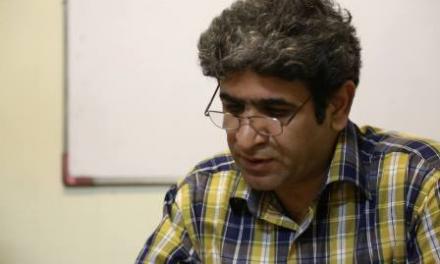
یهودا فرزند زیپورایی همان عیسی مسیح تاریخی است

 در اواخر حکومت هیرود کبیر دو معلم انقلابی یهود به نامهای یهودا پسر زیپورایی و ماتثیاس فرزند مارقالوت که شایعه مرگ هیرود کبیر را شنیدند، شاگردان خود را تشویق به بر افکندن تندیس عقاب طلایی (سمبل امپراطوری روم) از سر درب معبد اورشلیم نمودند. شاگردان ایشان جلو چشم مردم تندیس عقاب طلایی را پایین انداخته و خرد کردند. چون این خبر به هیرود کبیر رسید از این موضوع بسیار خشمگین شد و دستور داد نوجوانانی را که به سر درب معبد اورشلیم بالا رفتند و عقاب طلایی را پایین انداختند، سوزانده شوند و بقیه شاگردان با دو معلم شان اعدام گردند.
در اواخر حکومت هیرود کبیر دو معلم انقلابی یهود به نامهای یهودا پسر زیپورایی و ماتثیاس فرزند مارقالوت که شایعه مرگ هیرود کبیر را شنیدند، شاگردان خود را تشویق به بر افکندن تندیس عقاب طلایی (سمبل امپراطوری روم) از سر درب معبد اورشلیم نمودند. شاگردان ایشان جلو چشم مردم تندیس عقاب طلایی را پایین انداخته و خرد کردند. چون این خبر به هیرود کبیر رسید از این موضوع بسیار خشمگین شد و دستور داد نوجوانانی را که به سر درب معبد اورشلیم بالا رفتند و عقاب طلایی را پایین انداختند، سوزانده شوند و بقیه شاگردان با دو معلم شان اعدام گردند.
این واقعه به وضوح یادآور آن حادثه اساطیری انجیلها است که میگوید که هیرود کبیر دستور داد عیسی مسیح نوزاد با نوزادان هم سن و سالش در حومه اورشلیم اعدام گردند. بعلاوه یاد آور اعدام معلم انقلابی یحیی معمدان است که در جایگاه ماتثیاس فرزند مارقالوت قرار دارد که بنا به تصریح یوسف فلاویوس با حدود چهل تن از شاگردان خود و شاگردان یهودا فرزند زیپورایی اعدام شد. ولی یوسف فلاویوس مرگ یهودا فرزند زیپورایی را تصریح نمی کند و در لفافه میگوید که دستور هیرود کبیر مبنی بر اعدام آن دو معلم و شاگردان و سوزاندن شاگردان بالای سر درب معبد اورشلیم رفتگان به جای آورده شد و به خاطر این سرنوشت مظلومانه ایشان ماه خسوف کرد. از مترجمین آثار فلاویوس هم کسانی اذعان دارند که فلاویوس موضوع مربوط یهودای جلیلی (در معنی یهودای انقلابی، رهبر فرقه مشتاقان آزادی یهود) به عمد با کتمان بیان می کند. در واقع روایت انجیلی بر افکندن بساط کبوتر فروشان در حیاط معبد اورشلیمتوسط عیسی مسیح بازگویی همین واقعه ساقط کردن تندیس عقاب طلایی (سمبل امپراطوری روم) از سر درب بیت المقدس توسط شاگردان یهودا و ماتثیاس می باشد.
امّا واقعه فراری شدن عیسی مسیح با جمعی از شاگردان در واقعه قتل یحیی معمدان (ماتثیاس فرزند مارقالوت) به وضوح به فراری شدن یهودا فرزند زیپورایی و شاگردانش به سوی صحرای سینای مصر حکایت دارد. آنجا که در انجیلها بازگشت وی از مصر مدتها بعد از مرگ هیرود کبیر با عبارت “فرزند خود را از مصر فراخواندم” تصریح میشود. ولی در دایره المعارفها به سهو این یهودای انقلابی (جلیلی) با یهودای فرزند حزکیا، اهل جلیلیه که بعد از مرگ هیرود کبیر در بین سالهای ۴تا ۶ میلادی شورشی نظامی علیه رومیان نموده بود، یکی گرفته شده است. ولی مورخین بازگشت یهودای انقلابی (جلیلی) را در عهد کوپونیوس (۶تا ۹ میلادی) با چنین گفتاری از وی بیان کرده اند: ” این شرم آور است که به رومی ها باج بدهیم و افزون بر خدای یکتا کسی را به سروری خود قبول کنیم” که شباهت تامّ دارد با آموزه رسولان مسیحی در انجیلها که میگوید: “مهمتر اطاعت خداست تا اطاعت بندگان”.
در انجیلها به معنی نام پدر یهودای انقلابی در مقام پدر عیسی مسیح چنین اشاره میشود: بعد از آن که عیسی مسیح توسط یحیی معمدان غسل تعمید گرفت، در راه کبوتری در آسمان ظاهر شد و صدایی بر خاست که تو فرزند دلبند من هستی که از تو بسیار خشنودم (به عبارت دیگر تو ستوده من هستی). یهودا به معنی ستوده خدا و زیپورایی به معنی نوعی پرنده است.
مسلم به نظر اعتقاد به منجی زرتشتی استوت ارته (در معنی ستوده به پاکی) و منجی اعراب، احمد/محمد (ستوده شده) از معنی لفظی لقب و نام اصلی عیسی مسیح (منجی پاک) یعنی خود لقب عیسی مسیح و یهودا (ستوده خداوند) بر خاسته اند.
عناوین آدونیس (سرور من) و عیسی مسیح (منجی پاک) بعد از بازگشت از مصر در زندگی نیمه یهودای انقلابی به وی داده شده اند. چون در عنوان آدونیس (سرور من) با آدونیس خدای فینیقی همنام شده است لذا مراسم و اسطوره این ایزد میرنده و زنده شونده نباتی به یهودای انقلابی نسبت داده شده است. نام مادر فراری و دایۀ آدونیس یعنی میرا و پرسفونه به صورت ماریا (مریم) و یوسف به عیسی مسیح تعلق گرفته است.
متن انگلیسی کامل همین مقاله را که پیشتر تدوین نموده ام در اینجا می آورم:
Who has been the historical and mythical Jesus Christ?
The answer is:
Judas the zealot, son of Zipporai and the holy young god Adonis
According to Josefus Flavius (a Jewish historian from the first century) the name Jesus Christ can only be a pet name because Josefus tells of all important events and all famous persons in Judaea in the first century but he actually does not know of anyone named Jesus Christ.* It is therefore imperative to seek the real historical name of Jesus Christ. This is an important world enigma. A group of historians do not at all believe that there has existed a man named, or with the epithet, Jesus Christ or any man with a similar character. Albert Schweitzer for instance claims: “The man called Jesus Christ, who appeared as the Messiah, preached the morality of the kingdom of God, founded the kingdom of heaven on earth and died to give his works its final sanctity, this man has never existed.” Another group, who are profound believers in the New Testament, has no doubts that Jesus Christ has been a half god/half man who existed in the beginning of our epoch with the characteristics described in the New Testament. I, myself, belong to a third category believing that there is an historic core concerning Jesus Christ in the New Testament; there has existed a provincial revolutionary Jewish leader in Palestine with the majority of the characteristics attributed to Jesus Christ. It can be proven that this revolutionary priest has been Judas, son of Zipporai, founder of the zealot party. This man lived twice as long as believed and he had a family and children.
*If one deletes the false supplements concerning Jesus Christ and St John the Baptist present in Josefus Flavius’s work “The ancient history of the Jews”.
Judas, son of Zipporai, is the historical Jesus Christ
Judas of Galilee, who made political and cultural rebellion in Jerusalem ۵ B.C. and between 6 and 30 A.D., was not the same Judas of Galilee who fought the Romans from 4 B.C. until 6 A.D. This great mistake, to equalize these two persons, has caused many problems for the history of divinity. The first, and unknown, Judas of Galilee is the historical Jesus Christ while the other Judas of Galilee originally came from the city Gamala, east of the Lake of Galilee (the Kinnertlake). His father was Hezekiah, a robber killed by Herod the Great. According to Josefus Flavius and the Acts of the Apostles this Judas of Galilee broke open the king’s artillery depot in the city of Sepforis, armed his people but was conquered and killed by Quinctilius Varus, governor of Syria 4 B.C. to 6 A.D.
The first Judas of Galilee, equal to Judas, son of Zipporai, was a famous priest/philosopher and his struggle against the Romans was indeed ideological. Josefus Flavius (37-100 A.D.) tells this story about him:
VIII
Judas of Galilee. The three Jewish religious parties
The territory of Arkelai was turned into a province and a Roman knight by the name Koponius was sent there as governor with total power granted by the emperor. During his time (6-9 A.D.) a certain Galilee by the name of Judas seduced his fellow countrymen to apostasy in claiming that it was a shame paying taxes to the Romans and recognizing mortal men and rulers as their gods. He founded his own sect which had noting in common with the other sects that were formed. ***
*** This is one of the passages in which Josefus deliberately withholds the real facts.
Josefus tells the following about Judas of Galilee and his son Manaim:
A certain man named Manaim (Menahem), son of the renowned sophist (scribe) Judas with the surname the Galilee had on one occasion, while Quirinius was governor, reproached the Jews in obeying both God and the Romans. He went to Massada with his followers and broke open the artillery depot of King Herod the Great and armed his fellow countrymen as well as foreign robbers. He returned to Jerusalem as leader of this troop which also constituted his body guard as had he been a king…
This scribe Judas who founded the Zealot party (the zealous) must be Judas, son pf Zipporai. His followers pulled the great golden eagle (the symbol of the Roman Empire) off the gate to the famous Temple in Jerusalem and smashed it into pieces.
In the encyclopaedia Judaica we can read the following about Judas and his followers:
JUDAH, SON OF ZIPPORAI (first century), a patriot.
According to Josephus, Judah was a sophist of highest reputation among the Jews, an unrivalled interpreter of their ancestral laws, and educator of the youth. Taking advantage of Herod’s illness (4 B.C.) he, together with his friend and fellow scholar Matthias son of Margalot, persuaded their disciples to pull down the gold eagle, the symbol of Rome, which Herod had erected over the great gate of the Temple, since it was contrary to Jewish law. The two scholars together with their disciples were burnt alive on the command of Herod shortly before his death.
Josefus tells us indirectly in “The Jews’ war against the Romans” that Judas and his friend Matthew and some of their followers were burnt by Herod the Great:
Very reluctantly the king gave his approval to this; he burnt those who had climbed up on the roof alive and even so the other scribes. The other ones who had been imprisoned he handed over to the hangman for their execution.*
The place where this happened was Jericho, northwest of Jerusalem.
But when he tells more about this event in “The old history of the Jews” he only says: Matthew and some followers were burnt to death and many followers were executed. They were at least 40.
Judas, son of Zipporai, and some of his followers saved themselves from this event and managed to escape south into Egypt, very likely to the Sinai desert to the independent half Armenians and half Arabic nabatheans. However Judas and his followers surely came to Judea after 6 A.D. when Arkelaos, son of Herod the Great, was dethroned. The following notes make it ascertain that Judas son of Zipporai has been the historical Jesus Christ.
- Judas was like Jesus born in Galilee.
- He had followers which trudged along with him on long walks to different cities in Palestine.
- His followers acknowledged him as a religious and political leader of the entire Judea.
- In the Gospel according to St. Matthew, 14, there is this report: “Then came the disciples of St. John the Baptist (actually Matthew’s disciples) to collect the body of St. John and berry it and they went to Jesus to tell him what had happened. When Jesus was told the news he went away in a boat to a remote place where he could be alone.” Judas son of Zipporai managed however to escape from the wrath of King Herod the Great, while his friend Matthew and 40 of their followers were burnt to death or
- As we know Herod ordered the execution of about 40 of Judas’s and Matthew’s young followers at the time of Jesus’ birth. In the Gospel according to St. Matthew it is stated that Josef and Mary and the newborn child fled into Egypt while the other newborn boys in Bethlehem were killed by Herod’s soldiers.
- During his lifetime Judas was a famous and learned scholar among the Jews and he tried to reform the culture and society of the Jews and liberate it from Romanization.
- According to Judas’s teaching it was a shame that they paid taxes to the Romans and recognized, except god, mortal men as their governors. This phrase is comparable to the passage 29/5 in the Acts of the Apostles in which Peter and the Apostles answer: “It is more important to obey god than to obey men.”
- In the Gospel according to St. Marc 1 we can read the following: one day Jesus of Nazareth in Galilee came to the Jordan River and was baptised by St. John. In the very moment when Jesus rose from the water he saw the heaven open and the Holy Ghost lowered down over him as a dove and a voice from heaven said: “you are my beloved son. You are my chosen one.” We know that Judas’s father’s name, i.e. “Zipporai” is the name of a bird and “Judas” means promised.
- Two of Judas’s sons who ruled the Zealot party and were crucified by the Romans 47 A.D. were named Simon and Jacob (James). We know that they were recognized as brothers to Jesus Christ in the New Testament. It is also interesting that they also have a brother named
- As we have stated the followers of Judas and Matthew pulled down the golden eagle, placed over the gate to the famous temple in Jerusalem, and smashed it into pieces. In the Apostles according to St. Matthew 12/21 it is however stated: “Then Jesus went into the temple in Jerusalem and forced the merchants out and pulled over the moneychangers tables and the booths were pigeons were sold”. According to the historical researchers there has never been anything sold in the Jerusalem Temple. An historic fact must therefore be the destroying of the golden eagle by the followers of Judas and Matthew.
- Judas’s name which means praised and promised can be regarded as synonymous to Jesus, which means the saviour.
- In the Apostles according to Matthew Jesus was named Nazarene (Galilee) after his return from Egypt. Thus has Judas son of Zipporai (the historical Jesus Christ) not been called the Galilee earlier.
A careful investigation of the myths of Adonis and the evangelical stories reveals a connection between the Adonis-cult and the early Christianity:
According to the famous Phoenician and Greek Adonis-myth there was a king in Syria by the name Téias (god). Aphrodite (goddess of love) forced his daughter Mira to make love to Téias for twelve dark nights. After these twelve nights Téias realized that this lady was his own daughter “Mira”. He decided to kill her but she managed to escape to the gods, they transformed her into the Myrrhe tree. After ten months she gave birth to “Adonis” (the lord). Aphrodite, who was very surprised by the beauty of the child, left him in care to Persephone (the goddess of the underworld). Persephone liked this lovely child and had therefore no intention of leaving him back to Aphrodite. There was a conflict between these goddesses but the goddess of poetry “Calliope” (according to other stories Zeus himself) solved this conflict in the manner that Adonis lives one third of the year with “heavenly Aphrodite” and one third in the underworld with Persephone and the rest of the year he may choose for himself. He chose to spend this with Aphrodite.
On the basis of the cult of the Phoenicians, Adonis died on a special day but rose the day after from his death. The Phoenicians mourned and celebrated these two days: The day he died they mourned, the women cried while the men arranged funeral ceremonies. They used an image of him. The next day they celebrated the resurrection of Adonis and in doing so they lifted up the image of Adonis.*
*Sir James George Frazer: Adonis. Attis. Osiris. London 1907.
There is reason to believe that the word Adonis (the lord), which was another name for the Phoenicians Baal (the lord) and a natural pet name for Judas son of Zipporai, equalized the god Adonis with the philosopher Judas, and these two divine and priestly dimensions together formed the divine and human characters of Jesus Christ. Christianity of course baptised this Adonis-myth and Adonis-cult. In this myth Téias, Mira, Myrrhe* and Persephone are comparable to the God, Herod, Mary, Misraim(Egypt) and “Josef” (the “educator” of Jesus Christ) in the New Testament. This connection and blending was most certainly done in the time of the Apostle St. Marc because Marc’s own mother was named Mary and his beloved uncle was named Josef, who according to the Acts of the Apostles got the pet name Barnabas the Preacher. These three people (Marc whose actual name was John, Mary and Josef) together with Paul and Peter played an important role in the ideological making, existence and development of Christianity.
In the Gospel according to St. Matthew 11/2 the three wise men from the east brought with them, among other things, myrrh as a gift to the newborn Jesus child. Mary (Mariam) means holy mother in Syrian. She is actually the Greek’s Demeter (holy mother) who raised a Greek kingly child with the opposite sex to Jesus, i.e. Demofon (the slayer of people). His mother is called Metarina (the far away planted).
SUMMARY
If the myths of Adonis are removed from the Gospels the remaining contents concern Judas son of Zipporai. Judas of Galilee, killed by Quinctilius Varus 5 A.D. was not the same Judas of Galilee who appeared 6 A.D. and was the founder of the Zealot party. This Judas of Galilee appeared when Quirinius was governor of Syria instead of the above just mentioned Quinctilius Varus. This Judas of Galilee, who we equalize with Judas son of Zipporai, is the historical Jesus Christ.
- درباره نویسنده:
- تازهترینها:
جواد مفرد کهلان محقق تاریخ اساطیری ایران



































































